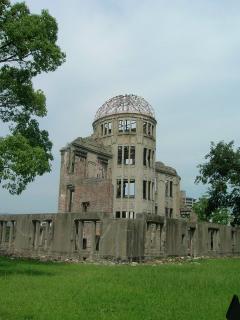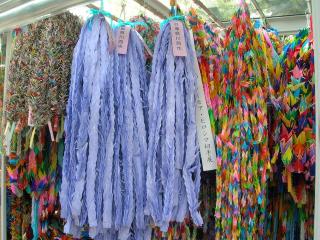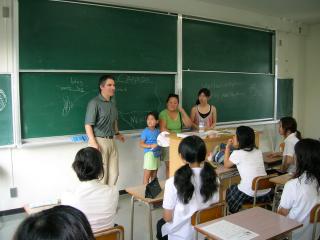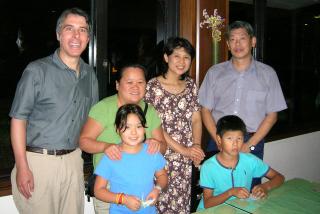Hiroshima & Fukuoka Japan: Sayonara!
Here's a little secret about long term travel. It is often the sights that you go to see, but it's the people you remember. This is true for us as we leave Japan with a fond farewell.
Sixty years ago this month, the United States dropped the first atomic bomb on a civilian population, effectively destroying the city of Hiroshima and providing the penultimate event leading to the end of World War II. This we all know from history books. We went to Hiroshima to see how the city (and Japan) commemorated this, as well as what it's like in Hiroshima today. What we saw was a vibrant, very much alive, industrial city. The Peace Museum has a fantastic exhibit that talks about Japan's role in World War II, life in Hiroshima before the war, the bombing itself and the recovery and rebuilding of the city. We've been to Pearl Harbor, I (Loey) have been to a concentration camp in Mauthausen Austria, and having come to Hiroshima we can only say that war seems pretty pointless and horrific. It seems that the leaders usually retreat unscathed and the true brunt of the devastation is always borne by the people going about their daily lives.

Before coming to Hiroshima, I had read about the World Friendship Center and booked us a room there during our stay. The WFC has been around for decades, and is run by a volunteer couple from the US, serving a two year term. The center facilitates discussions with the residents of Hiroshima and also provides a resource for travelers. We met Don and Pauline Hess from Virginia who were three months into their term. They were friendly hosts, who provided us with great conversation and French toast! They also arranged a short tour of the peace park with a Japanese volunteer, who taught us a lot about the monuments.
The amazing thing about Hiroshima is how thoroughly the city has recovered. Were it not for the peace park, monuments and museums, Hiroshima would look almost indistinguishable from most other Japanese industrial towns. Just a block from the "A-bomb dome," there's a big shopping street with lots of young people going in and out of the McDonald's, Nike, record and clothing stores. It all seems so normal until you step out into the middle of the park and realize that sixty years ago the space that's presently open was filled with homes and businesses just as dense as the surrounding neighborhood and it was all destroyed in an instant, with over 350,000 dying because of the explosion. It was a very depressing place, but also one of hope, as we saw all the paper cranes sent by people from around the world as wishes for peace.

When we started telling people about our travel plans, our friends Tori and Glen told us about Servas, and suggested that we look into it. Servas is an organization that believes that it is possible to facilitate world peace through short homestays, the theory being that it's harder to support bombing a country when you have such fond memories of the people who hosted you. It seemed appropriate after visiting Hiroshima to e-mail some Servas members in Fukuoka and see if anyone was available to host us.
Why Fukuoka? While sitting in the relative comfort of our home, we were looking at a world map, and asked ourselves what would be the most creative way to get from Japan to Korea. Hey, we thought, they look close together: why not take a ferry? We discovered that a hydrofoil leaves from Fukuoka Japan to Busan Korea everyday, and so our choice was made, we would leave Japan from Fukuoka. Fukuoka is home to one of the largest ports in Japan, the largest city on the Japanese island of Kyushu, Canal City (a really fun huge mall) and our host, Masatoshi Yonenaga. Masa is an English teacher at Kurume technical high school, about 30 km south of Fukuoka. We had a wonderful time visiting with our host for a day, while we went to one of his high school English classes. We were actually the featured guests for his class and were invited to talk about our trip and answer questions they had about the U.S.

Later we went out to dinner with his wife Motoko and 9 year old son Kazuano. They took us to a restaurant that featured organic foods, and we had great conversations and an impromptu origami lesson, where we learned to fold paper cranes. With a fond farewell, we bid the Yonenagas and Japan sayonara.

Sixty years ago this month, the United States dropped the first atomic bomb on a civilian population, effectively destroying the city of Hiroshima and providing the penultimate event leading to the end of World War II. This we all know from history books. We went to Hiroshima to see how the city (and Japan) commemorated this, as well as what it's like in Hiroshima today. What we saw was a vibrant, very much alive, industrial city. The Peace Museum has a fantastic exhibit that talks about Japan's role in World War II, life in Hiroshima before the war, the bombing itself and the recovery and rebuilding of the city. We've been to Pearl Harbor, I (Loey) have been to a concentration camp in Mauthausen Austria, and having come to Hiroshima we can only say that war seems pretty pointless and horrific. It seems that the leaders usually retreat unscathed and the true brunt of the devastation is always borne by the people going about their daily lives.

Before coming to Hiroshima, I had read about the World Friendship Center and booked us a room there during our stay. The WFC has been around for decades, and is run by a volunteer couple from the US, serving a two year term. The center facilitates discussions with the residents of Hiroshima and also provides a resource for travelers. We met Don and Pauline Hess from Virginia who were three months into their term. They were friendly hosts, who provided us with great conversation and French toast! They also arranged a short tour of the peace park with a Japanese volunteer, who taught us a lot about the monuments.
The amazing thing about Hiroshima is how thoroughly the city has recovered. Were it not for the peace park, monuments and museums, Hiroshima would look almost indistinguishable from most other Japanese industrial towns. Just a block from the "A-bomb dome," there's a big shopping street with lots of young people going in and out of the McDonald's, Nike, record and clothing stores. It all seems so normal until you step out into the middle of the park and realize that sixty years ago the space that's presently open was filled with homes and businesses just as dense as the surrounding neighborhood and it was all destroyed in an instant, with over 350,000 dying because of the explosion. It was a very depressing place, but also one of hope, as we saw all the paper cranes sent by people from around the world as wishes for peace.

When we started telling people about our travel plans, our friends Tori and Glen told us about Servas, and suggested that we look into it. Servas is an organization that believes that it is possible to facilitate world peace through short homestays, the theory being that it's harder to support bombing a country when you have such fond memories of the people who hosted you. It seemed appropriate after visiting Hiroshima to e-mail some Servas members in Fukuoka and see if anyone was available to host us.
Why Fukuoka? While sitting in the relative comfort of our home, we were looking at a world map, and asked ourselves what would be the most creative way to get from Japan to Korea. Hey, we thought, they look close together: why not take a ferry? We discovered that a hydrofoil leaves from Fukuoka Japan to Busan Korea everyday, and so our choice was made, we would leave Japan from Fukuoka. Fukuoka is home to one of the largest ports in Japan, the largest city on the Japanese island of Kyushu, Canal City (a really fun huge mall) and our host, Masatoshi Yonenaga. Masa is an English teacher at Kurume technical high school, about 30 km south of Fukuoka. We had a wonderful time visiting with our host for a day, while we went to one of his high school English classes. We were actually the featured guests for his class and were invited to talk about our trip and answer questions they had about the U.S.

Later we went out to dinner with his wife Motoko and 9 year old son Kazuano. They took us to a restaurant that featured organic foods, and we had great conversations and an impromptu origami lesson, where we learned to fold paper cranes. With a fond farewell, we bid the Yonenagas and Japan sayonara.


0 Comments:
Post a Comment
<< Home